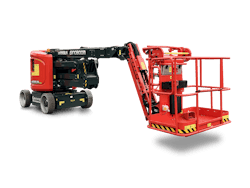Interview with Sinoboom: Electric, Compact and Reliable
Joey Liu, marketing manager, Sinoboom, talks with RER about compact electric solutions, its anti-collision radar device accessory, the move to smarter lifts; and more.
RER: What are the most important developments in mobile elevating work platforms in the past year - especially technology that would be of interest to rental companies?
Liu: Across the industry, we’re seeing three clear shifts: stronger connectivity, rising demand for electric narrow machines, and smarter safety technologies. At Sinoboom, we’ve been working with Trackunit to launch a telematics system, Sinoboom Link, giving rental companies powerful tools for remote diagnostics and fleet management. To meet the growing call for compact electric solutions, we introduced the 1530EN and 1930EN micro scissors, along with the new AB430ERJN and AB490ERJN narrow articulated booms built for tight indoor applications where space is limited. And on the safety front, our anti-collision radar device accessory adds an extra layer of operator protection, aligning with the industry’s focus on both productivity and safety.
What’s new in your company’s MEWP offering over the past year or so?
Liu: Newer products include the AB430ERJN and AB490ERJN telescopic boom lifts which are built for compactness on an X-style chassis, a factor which allows them to be easily transported on flatbed trucks or in containers – minimizing transportation costs. New-generation electric and diesel RT scissor lifts 4389RE / RD and 5389RE / RD enhance efficiency, with modular designs streamlining maintenance across models.
What are some of the most interesting applications for MEWPs that you’ve seen currently or over the past year or so?
Liu: One of the most interesting applications we’ve seen recently is in large-scale semiconductor megaprojects. These facilities require extremely high standards for safety, precision, and efficiency, and MEWPs play a critical role in installation and maintenance within clean room environments. The demand for compact, narrow electric machines is especially strong here, since they can navigate tight spaces and operate without emissions. Beyond semiconductors, we’re also seeing MEWPs heavily used in renewable energy projects, such as wind and solar installations, where access at height is both frequent and challenging. The common thread across these applications is the push for equipment that is electric, compact, and highly reliable — aligning perfectly with the direction the industry is heading.
Rental companies can all read the manufacturers instruction or IPAF “how to use” documents, and pass that documentation on to the customers, but what are some of the most important tips or suggestions for safety on aerial equipment that you would like to pass along to rental companies? What are the most common mistakes renters of aerial equipment make?
Liu: The most common mistakes we see are renters skipping pre-use checks, overloading the platform, not using fall protection, and not paying attention to obstacles like power lines or walls. I’d encourage rental companies to remind customers of these basics every time they hand over a machine. Simple features like the pothole protection system on scissors help keep machines stable, but operators still need to use good judgment and check ground conditions. At Sinoboom, we’ve also introduced accessories like the anti-collision radar device to add another layer of operator protection — but safe habits are always the first line of defense.
Looking ahead, what are the next new development or developments in aerial equipment technology? What are some developments you would like to see? What’s on the horizon?
Liu: Looking ahead, the industry is clearly moving toward smarter lifts. We’ll see more use of AI, with features like predictive obstacle response, precision positioning, and even elements of autonomous control. These advances will enhance both safety and productivity, and we’re excited about making this kind of assistive autonomy a reality for operators and rental fleets.
About the Author
Michael Roth
Editor
Michael Roth has covered the equipment rental industry full time for RER since 1989 and has served as the magazine’s editor in chief since 1994. He has nearly 30 years experience as a professional journalist. Roth has visited hundreds of rental centers and industry manufacturers, written hundreds of feature stories for RER and thousands of news stories for the magazine and its electronic newsletter RER Reports. Roth has interviewed leading executives for most of the industry’s largest rental companies and manufacturers as well as hundreds of smaller independent companies. He has visited with and reported on rental companies and manufacturers in Europe, Central America and Asia as well as Mexico, Canada and the United States. Roth was co-founder of RER Reports, the industry’s first weekly newsletter, which began as a fax newsletter in 1996, and later became an online newsletter. Roth has spoken at conventions sponsored by the American Rental Association, Associated Equipment Distributors, California Rental Association and other industry events and has spoken before industry groups in several countries. He lives and works in Los Angeles when he’s not traveling to cover industry events.
